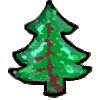Characters of species those of genus. Simple leaves 14.0–17.0 mm long, 2.8–3.0 mm wide, on antepenultimate branches 5.0–12.5 mm long, 1.0–1.5 mm wide, on penultimate branches 3.0–6.0 mm long, 0.4–0.5 mm wide, on ultimate branches; adaxial stomata, six to eight subsidiary cells with overarching and erect papillae; abaxial trichome bases present. Pollen cone ca. 16.0 cm long, 6.0 mm wide; bracts 3–5 mm long, 0.8–2.0 mm wide; stomata with four to eight subsidiary cells; papillae numerous and erect. Polliniferous dwarf shoots with five to eight sterile scales 0.6–1.1 mm long,
0.2–0.4 mm wide, mucronate; stomata with four to eight subsidiary cells and erect papillae. Pollen sacs ellipsoidal, attenuate, rounded, 0.8–1.2 mm long, 0.3–0.6 mm wide. Grains 60–130 mm, with two parallel crescent-shaped folds at sides of the central body. Ovulate fertile zones 3.0–4.5 cm long, 0.9–1.5 cm wide; bracts 8.0–11.0 mm long, 1.0–1.5 mm wide, linear and S shaped, decurrent, mucronate; trichome bases regularly spaced; stomata evenly distributed, with four to six subsidiary cells and erect papillae. Axillary ovulate shoots 8.0–9.0 mm long, 6.0–7.5 mm wide, with 10–15 sterile scales and three to four sporophylls. Sterile scales 2.0–5.0 mm long, 0.3–0.6 mm wide, helically arranged around shoot, attached
near base; stomata with four to six subsidiary cells and erect papillae. Sporophylls 3.0–4.0 mm long, 1.0–1.5 mm wide, with numerous papillae. Seeds oval to elliptical, 2.0 mm long, 1.0 mm wide
Thucydia mahoningensis sp. nov.
nomenclatorial act:
protologue/first publication
Page:
1160
diagnosis:
systematic position:
Spermatopsida, Voltziales, Thucidiaceae
typeseries:
Holotype. Specimen OUPH-13450 (GR-1), figures 10D and 11E, here designated the holotype; reposited in the Ohio University Paleobotanical Herbarium.
Paratypes. External morphology of vegetative shoots (G200) OUPH-13411 (fig. 2A); cuticles OUPH-13426 (M2019 u1) (fig. 6A, 6L); OUPH-13427 (M2006) (fig. 6B, 6C, 6K, 6M); OUPH-13429 (G1A3) (fig. 6E, 6F, 6H, 6N). Anatomy OUPH-13424 (M1451 a8) (fig. 5D); OUPH 13425 (M1454 f3) (fig. 5E); OUPH-13437 (M-1454 f17) (fig. 7A); OUPH-13438 (M2019 b10) (fig. 7B); (M2019 c1) OUPH-13439 (fig. 7C); (M2019 c2) OUPH-13440 (fig. 7D); OUPH-13444 (M2019 b4) (fig. 7I, 7N, 7O); OUPH-13446 (M2019 c3) (fig. 7L, 7M). Compound pollen cone OUPH-13457 (G82) (fig. 8A, 8B); OUPH-13458 (G82) (fig. 8C); OUPH-13457 (G82) (fig. 8D); OUPH-13460 (G82) (fig. 8E, 8G; fig. 9A, 9B); G82 (OUPH-13461) (fig. 8F; fig. 9C, 9E); OUPH-13462 (G82- pcp6) (fig. 9D); OUPH-13463 (G82-pcp5) (fig. 9F); OUPH-13465 (G82-pcp4) (fig. 9H). Fertile zones OUPH-13447 (GR- 11) (fig. 10A); OUPH-13451 (GR-17) (figs. 10E, 11C); OUPH-13455 (GR-16) (fig. 13A, 13B, 13G). The specimens are reposited in the Ohio University Paleobotanical Herbarium.
locality:
stratigraphy:
Classification:

Add new comment